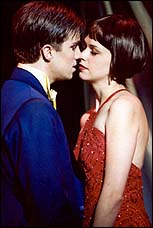Filichia Features: Thoroughly Modern Millie Grazie
Filichia Features: Thoroughly Modern Millie Grazie
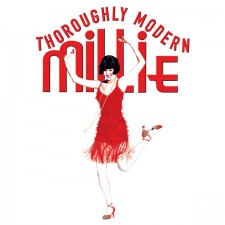 Audiences love when a character makes a fast costume change. If it happens with enough speed, they almost feel as if they’re getting two characters for the price of one.
Audiences love when a character makes a fast costume change. If it happens with enough speed, they almost feel as if they’re getting two characters for the price of one.
That opportunity arises only moments into Thoroughly Modern Millie, after Salina, Kansas native Millie Dillmount has arrived in New York City. It’s the start of the Roaring ‘20s, and Millie wants the roaring to start.
But is she dressed for the occasion? Once she sees everyone walking and rushing around her, she realizes that her Kansas Sunday best won’t work on any day of the week in Manhattan.
So Millie goes through a revolving door – and after she does, anyone directing Thoroughly Modern Millie had best have some crackerjack costume-changing dressers backstage. If your audience doesn’t “Ooooh!” in amazement when Millie returns seconds later in her short skirt and bobbed hair, you’ve missed a wonderful opportunity to put the crowd squarely on your side. Letting theatergoers know that you can accomplish the seemingly impossible will immediately give them confidence that they’re going to see a wonderful production.
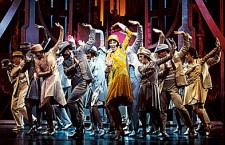
Original Broadway cast in the opening number
The stylish clothes help Millie to feel that she’ll soon get what she wants: husband, house, a mortgage, a baby – with the first-named providing the second and fourth items while he pays off the third. And where would a young miss be more likely to meet such a prize than in a large and thriving company? Millie gives us the impression that food, shelter and clothing are all tied for second place behind the first-prize winner: an eligible executive whom she can charm and claim.
Gold diggers usually inspire our distrust if not disgust. A director can, however, avoid the issue by casting an actress with wide-eyed naiveté. Millie must seem misguided rather than craven. In essence, we must inherently know more about her than she knows about herself. We infer that try as she might to marry solely for money, she’s at heart “a nice girl” who’ll fall in love for the right reasons when Mr. Right comes along.
He does, in the guise of Jimmy, who can barely spare a penny to weigh himself on a scale that sits outside a drug store. But because Jimmy is so pleasant and appealing, Millie can’t help caring for him. In the end, our so-called “thoroughly modern” Millie will turn out to be refreshingly old-fashioned. What she’ll mine from all that gold digging is Jimmy’s golden personality.
Or so it seems as Act One is coming to a close. But quite often in musical comedy, exhilaration is followed by deep despair. For example, after Maria decides to return to the von Trapps and claim the Captain, she immediately learns he’s been engaged to Elsa. Once Annie realizes that she’ll never find her parents and embraces Oliver Warbucks as her daddy, in come Mr. and Mrs. Mudge to reclaim her.
And here, in Thoroughly Modern Millie, as soon as our heroine decides to abandon her get-rich-quick goal and tell Jimmy that she loves him, she spies him leading her newfound friend Miss Dorothy into his bedroom.
We’re as crushed as she. What do you get when you fall in love? A guy with a pin to burst your bubble. But all will end well – although Richard Morris, who wrote the 1967 film on which the 2002 musical is based, kept us guessing. He had Millie learn only minutes before the fade-out that Jimmy is no pauper, but a smart young tycoon who hid his wealth so that a woman would fall in love with him and not his bankbook and portfolio. Stage adaptor Dick Scanlan also held the secret in reserve right up to the final curtain.
So why did Jimmy bring Miss Dorothy to his room late at night? The two just wanted to compare notes, as brother and sister do from time to time. Their step-mother Muzzy thought that her two step-siblings would learn a great deal about life if they went out into the world and saw how the other 47% lives.
So Thoroughly Modern Millie keeps almost as many secrets as a murder mystery. Come to think of it, the show almost contains a murder and certainly involves a mystery -- courtesy of Mrs. Meers, who runs the boarding house where Millie and Miss Dorothy reside.
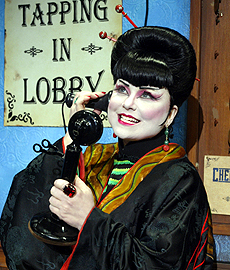
Delta Burke as Mrs. Meers in Original Broadway Cast
The real reason that Mrs. Meers took the job is to have easy access to young women who will replenish the white slavery ring she’s running. Actually, that sounds pretty serious, so that may be one reason why Scanlan and his composer and co-lyricist Jeanine Tesori wanted to treat the abduction issue in a farcical way: by having Mrs. Meers speak pidgin Chinese.
As Scanlan wrote in his script, “Mrs. Meers should be encouraged to embrace the offensiveness of her politically incorrect rendering of Asian, confident in the knowledge that, when contrasted with the actual Asian characters we meet later on, her depiction of a hateful stereotype will be busted as inauthentic and absurd.”
Interesting: in the film that had been made 35 years earlier, Beatrice Lillie didn’t play Mrs. Meers with any kind of accent at all. She simply spoke. And that was a less politically sensitive time, too.
Mrs. Meers’ henchmen Bun Foo and Ching Ho are those “actual Asian characters we meet later.” Cast actors who speak as if English were their second language with, of course, Chinese their first. They must deliver their dialogue at a lickety-split pace that leaves no doubt that they were born in The People’s Republic. (MTI cheerfully provides an audio instructional guide to correct pronunciation.)
What Bun Foo and Ching Ho say to each other, then, must be translated for the audience. “The Broadway production employed supertitles on a screen hung over the stage,” say the authors. “There are other ways to handle the translation, from high-tech to handheld signs.”
Here’s betting, however, that without much difficulty you’ll locate high-tech wizards who’ll gladly create projections for you. See if you can find people who have never even seen the inside of a theater; that way, once you get them inside, they will find – as the rest of us have – that there’s no place else on earth that they would rather be.
While Jimmy easily shucked his high-born ways, his sister did not. Notice that she’s referred to as Miss Dorothy. Anyone who simply uses her first name when talking with her will be immediately reprimanded. Finding the right actress to play Miss Dorothy (Carnegie Mellon Vanderbilt Van Hossmere, if you please) should be next to effortless in these days when over-pampered children are not in short supply. Every organization will have at least one young woman who possesses this character’s intense sense of entitlement.
What both Miss Dorothy and Millie must do is tap well. Scanlan retained a gimmick from the movie: that the hotel’s elevator doesn’t work unless its users bang on the floor – which, in a musical, translates to tapping.
Where, you’re asking, am I going to get an elevator? Scanlan and Tesori feel your pain. “There are other ways to render it,” they say, before suggesting “a square of light on the floor with a floor indicator overhead. The authors welcome thinking outside the box,” they add, arguably unaware that they’d made a pun. “But in no event should the conceit of the tap dancing elevator be eliminated.” ‘Nuff said.
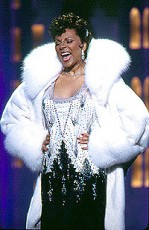
Leslie Uggams as Muzzy in the Original Broadway Cast
As for Muzzy – played in the film by the Oscar-nominated Carol Channing -- the stage production cast an African-American actress in the role of this madcap party giver. While of course a stepmother can be any race, color or creed, one could effectively argue that having a black Muzzy keeps even the sharpest of theatergoers from guessing her secret identity. Cast someone with great authority, because Scanlan describes Muzzy as “Pearl Bailey crossed with Josephine Baker, and a bigger star than either of them.”
Speaking of stars, Thoroughly Modern Millie gives not one, not two, not three but four young women the chance to shine. While of course Millie is the lead, the other three parts are so rich that any early jealousy and dissention will be mitigated as soon as the other three actresses take a good look at all they have to do.
Finally, have your set designer make your New York look like New York. The 1967 movie was shot on stage sets that had streets far too immaculate and pristinely paved to resemble Manhattan. This advice also holds for your lighting designer. In the film, the warm Hollywood sun was much too much in evidence. On those old Manhattan streets, let the warmth thoroughly come from Millie, her supporting cast and the nice message about true love being its own reward.
 Read all of Filichia’s Features!
Read all of Filichia’s Features!
Visit Peter’s Official Website.
Check out Peter’s weekly column each Tuesday at www.masterworksbroadway.com and each Friday at www.kritzerland.com.
Peter’s newest book, Strippers, Showgirls, and Sharks: A Very Opinionated History of the Broadway Musicals That Did Not Win the Tony Award,is available for pre-order NOW!
